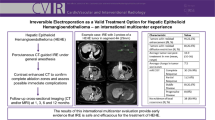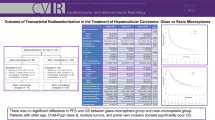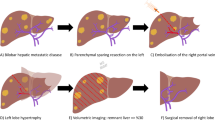Abstract
Long-term therapy for unresectable colorectal liver metastases remains challenging. Intraarterial treatments aim to avoid systemic adverse effects of chemotherapy. Nanoliposomal cytotoxic drugs manage to increase the drug concentration within the tumor while reducing toxicity in healthy tissue. In this study we analyzed the effect of hepatic arterial infusion (HAI) with nanoliposomal irinotecan with or without the combination of embolization particles in a rat model for colorectal liver metastases. For the study 32 WAG/Rij rats received subcapsular tumor implantation with CC531 rat colonic adenocarcinoma cells. After ten days tumor size was assessed via ultrasound and animals underwent HAI. One group served as control receiving NaCl 0.9 % (Sham), the three treatment groups received either nanoliposomal irinotecan (HAI nal iri), Embocept® S (HAI Embo) or Embocept® S and nanoliposomal irinotecan (HAI Embo+nal iri). Three days after treatment animals were sacrificed after assessment of tumor size. As a result all treatment groups showed a significant reduction in tumor growth compared to Sham (p<0.05). Expression of the apoptosis marker caspase-3 was enhanced in HAI nal iri and HAI Embo+nal iri compared to Sham and HAI Embo and even significantly enhanced after HAI Embo+nal iri in comparison to Sham (p<0.05). We were able to show that HAI with Embocept® S led to significantly reduced tumor growth while HAI with nanoliposomal irinotecan alone or in combination with Embocept® S even led to a reduction of tumor size. Thus, we demonstrate that intraarterial treatment with nanoliposomal irinotecan effectively inhibits tumor growth in a rat model of colorectal liver metastases and demands further investigation.



Similar content being viewed by others
Data Availability
The authors confirm that data and information about material will be made available to others without preconditions.
References
Kow AWC (2019 Dec) Hepatic metastasis from colorectal cancer. J Gastrointest Oncol 10(6):1274–1298. https://doi.org/10.21037/jgo.2019.08.06
De Greef K, Rolfo C, Russo A, Chapelle T, Bronte G, Passiglia F, Coelho A, Papadimitriou K, Peeters M Multisciplinary management of patients with liver metastasis from colorectal cancer. World J Gastroenterol. 2016 Aug 28;22(32):7215–7225. https://doi.org/10.3748/wjg.v22.i32.7215
Zhao J, van Mierlo KMC, Gómez-Ramírez J, Kim H, Pilgrim CHC, Pessaux P, Rensen SS, van der Stok EP, Schaap FG, Soubrane O, Takamoto T, Viganò L, Winkens B, Dejong CHC, Olde Damink SWM (2017 Jul) Chemotherapy-Associated Liver Injury (CALI) consortium. Systematic review of the influence of chemotherapy-associated liver injury on outcome after partial hepatectomy for colorectal liver metastases. Br J Surg 104(8):990–1002. https://doi.org/10.1002/bjs.10572
Habib A, Desai K, Hickey R, Thornburg B, Lewandowski R, Salem R (2015 Aug) Transarterial approaches to primary and secondary hepatic malignancies. Nat Rev Clin Oncol 12(8):481–489. https://doi.org/10.1038/nrclinonc.2015.78
McAuliffe JC, Qadan M, D’Angelica MI (2015 Dec) Hepatic resection, hepatic arterial infusion pump therapy, and genetic biomarkers in the management of hepatic metastases from colorectal cancer. J Gastrointest Oncol 6(6):699–708. https://doi.org/10.3978/j.issn.2078-6891.2015.081
Fiorentini G, Sarti D, Aliberti C, Carandina R, Mambrini A, Guadagni S Multidisciplinary approach of colorectal cancer liver metastases.World J Clin Oncol. 2017 Jun10;8(3):190–202. https://doi.org/10.5306/wjco.v8.i3.190
Pak LM, Kemeny NE, Capanu M, Chou JF, Boucher T, Cercek A, Balachandran VP, Kingham TP, Allen PJ, DeMatteo RP, Jarnagin WR, D’Angelica MI (2018 Mar) Prospective phase II trial of combination hepatic artery infusion and systemic chemotherapy for unresectable colorectal liver metastases: long term results and curative potential.J Surg Oncol. 117(4):634–643. https://doi.org/10.1002/jso.24898
Datta J, Narayan RR, Kemeny NE, D’Angelica MI (2019 Jun) Role of hepatic artery infusion chemotherapy in treatment of initially unresectable colorectal liver metastases: a review. JAMA Surg 12. https://doi.org/10.1001/jamasurg.2019.1694
Martin RC 2nd, Scoggins CR, Schreeder M, Rilling WS, Laing CJ, Tatum CM, Kelly LR, Garcia-Monaco RD, Sharma VR, Crocenzi TS, Strasberg SM Randomized controlled trial of irinotecan drug-eluting beads with simultaneous FOLFOX and bevacizumab for patients with unresectable colorectal liver-limited metastasis.Cancer. 2015 Oct15;121(20):3649–3658. https://doi.org/10.1002/cncr.29534
Kauffels A, Kitzmüller M, Gruber A, Nowack H, Bohnenberger H, Spitzner M, Kuthning A, Sprenger T, Czejka M, Ghadimi M, Sperling J (2019 Feb) Hepatic arterial infusion of irinotecan and EmboCept® S results in high tumor concentration of SN-38 in a rat model of colorectal liver metastases. Clin Exp Metastasis 36(1):57–66. https://doi.org/10.1007/s10585-019-09954-5
Ziemann C, Roller J, Malter MM, Keller K, Kollmar O, Glanemann M, Menger MD, Sperling J Intra-arterial EmboCept S® and DC Bead® effectively inhibit tumor growth of colorectal rat liver metastases. BMC Cancer. 2019 Oct 10;19(1):938. https://doi.org/10.1186/s12885-019-6135-x
Gruber-Rouh T, Marko C, Thalhammer A, Nour-Eldin NE, Langenbach M, Beeres M, Naguib NN, Zangos S, Vogl TJ (2016 Aug) Current strategies in interventional oncology of colorectal liver metastases. Br J Radiol 89(1064):20151060. https://doi.org/10.1259/bjr.20151060
Fujita K, Kubota Y, Ishida H, Sasaki Y (2015) Irinotecan, a key chemotherapeutic drug for metastatic colorectal cancer. World J Gastroenterol. Nov 21;21(43):12234–12248. https://doi.org/10.3748/wjg.v21.i43.12234
Zhang H Onivyde for the therapy of multiple solid tumors.Onco Targets Ther. 2016 May20;9:3001–7. https://doi.org/10.2147/OTT.S105587
Drummond DC, Noble CO, Guo Z, Hong K, Park JW, Kirpotin DB Development of a highly active nanoliposomal irinotecan using a novel intraliposomal stabilization strategy.Cancer Res. 2006 Mar15;66(6):3271–3277. https://doi.org/10.1016/j.jconrel.2009.08.006
Matsumura Y, Maeda H (1986 Dec) A new concept for macromolecular therapeutics in cancer chemotherapy: mechanism of tumoritropic accumulation of proteins and the antitumor agent smancs. Cancer Res 46(12 Pt 1):6387–6392
Benedict FG (1934) Die Oberflächenbestimmungen verschiedener Tiergattungen [Determination of body surface area in different animal species]. Ergebnisse der Physiologie und Experimentellen Pharmakologie 36:300–346
Workman P, Aboagye EO, Balkwill F, Balmain A, Bruder G, Chaplin DJ et al (2010) Guidelines for the welfare and use of animals in cancer research. Br J Cancer 102:1555–1577. https://doi.org/10.1038/sj.bjc.6605642
Institute of Laboratory Animal Resources, National Research Council (1996) Guide for the care and use of laboratory animals, 8th edn. NIH Guide, UK
Xu ZT, Ding H, Fu TT, Zhu YL, Wang WP A Nude Mouse Model of Orthotopic Liver Transplantation of Human Hepatocellular Carcinoma HCCLM3 cell xenografts and the Use of Imaging to Evaluate Tumor Progression.Med Sci Monit. 2019 Nov18;25:8694–8703. https://doi.org/10.12659/MSM.917648
Sperling J, Schäfer T, Ziemann C, Benz-Weiber A, Kollmar O, Schilling MK et al (2012) Hepatic arterial infusion of bevacizumab in combination with oxaliplatin reduces tumor growth in a rat model of colorectal liver metastases. Clin Exp Metastasis 29:91–99. https://doi.org/10.1007/s10585-011-9432-6
Calabrese F, Valente M, Pettenazzo E, Ferraresso M, Burra P, Cadrobbi R, Cardin R, Bacelle L, Parnigotto A, Rigotti P (1997 Dec) The protective effects of L-arginine after liver ischaemia/reperfusion injury in a pig model. J Pathol 183(4):477–485. https://doi.org/10.1002/(SICI)1096-9896(199712)183:4%3C477::AID-PATH955%3E3.0.CO;2-E
Thomas C, Nijenhuis AM, Timens W, Kuppen PJ, Daemen T, Scherphof GL (1993) Liver metastasis model of colon cancer in the rat: immunohistochemical characterization. Invasion Metastasis 13(2):102–112
White SB, Procissi D, Chen J, Gogineni VR, Tyler P, Yang Y, Omary RA, Larson AC (2016) Characterization of CC-531 as a Rat Model of Colorectal Liver Metastases. PLoS One. May 12;11(5):e0155334
Sperling J, Brandhorst D, Schäfer T, Ziemann C, Benz-Weißer A, Scheuer C, Kollmar O, Schilling MK, Menger MD (2013 Apr) Liver-directed chemotherapy of cetuximab and bevacizumab in combination with oxaliplatin is more effective to inhibit tumor growth of CC531 colorectal rat liver metastases than systemic chemotherapy. Clin Exp Metastasis 30(4):447–455. https://doi.org/10.1007/s10585-012-9550-9
Seelig MH, Leible M, Sänger J, Berger MR (2004 May) Chemoembolization of rat liver metastasis with microspheres and gemcitabine followed by evaluation of tumor cell load by chemiluminescence. Oncol Rep 11(5):1107–1113
Hutteman M, Mieog JS, van der Vorst JR, Dijkstra J, Kuppen PJ, van der Laan AM, Tanke HJ, Kaijzel EL, Que I, van de Velde CJ, Löwik CW, Vahrmeijer AL (2011 Mar) Intraoperative near-infrared fluorescence imaging of colorectal metastases targeting integrin α(v)β(3) expression in a syngeneic rat model. Eur J Surg Oncol 37(3):252–357. https://doi.org/10.1016/j.ejso.2010.12.014
Krause P, Flikweert H, Monin M, Seif Amir Hosseini A, Helms G, Cantanhede G, Ghadimi BM, Koenig S (2013 Jun) Increased growth of colorectal liver metastasis following partial hepatectomy. Clin Exp Metastasis 30(5):681–693. https://doi.org/10.1007/s10585-013-9572-y
Wang-Gillam A, Hubner RA, Siveke JT, Von Hoff DD, Belanger B, de Jong FA, Mirakhur B, Chen LT (2019 Feb) NAPOLI-1 phase 3 study of liposomal irinotecan in metastatic pancreatic cancer: final overall survival analysis and characteristics of long-term survivors. Eur J Cancer 108:78–87. https://doi.org/10.1016/j.ejca.2018.12.007
Chibaudel B, Maindrault-Gœbel F, Bachet JB, Louvet C, Khalil A, Dupuis O, Hammel P, Garcia ML, Bennamoun M, Brusquant D, Tournigand C, André T, Arbaud C, Larsen AK, Wang YW, Yeh CG, Bonnetain F, de Gramont A (2016 Apr) PEPCOL: a GERCOR randomized phase II study of nanoliposomal irinotecan PEP02 (MM-398) or irinotecan with leucovorin/5-fluorouracil as second-line therapy in metastatic colorectal cancer. Cancer Med 5(4):676–683. https://doi.org/10.1002/cam4.635
Kalra AV, Kim J, Klinz SG, Paz N, Cain J, Drummond DC, Nielsen UB, Fitzgerald JB Preclinical activity of nanoliposomal irinotecan is governed by tumor deposition and intratumor prodrug conversion. Cancer Res. 2014 Dec 1;74(23):7003–7013. https://doi.org/10.1158/0008-5472.CAN-14-0572
Pieper CC, Meyer C, Vollmar B, Hauenstein K, Schild HH, Wilhelm KE (2015 Apr) Temporary arterial embolization of liver parenchyma with degradable starch microspheres (EmboCept®S) in a swine model. Cardiovasc Intervent Radiol 38(2):435–441. https://doi.org/10.1007/s00270-014-0966-2
Acknowledgements
The authors thank Birgit Jünemann who helped establishing the immunohistochemistry staining.
Funding
AK’s salary during the time of the study and part of the study itself was funded by the Else Kröner-Fresenius-Stiftung (EKFS), Bad Homburg v.d.H, Germany, due to a scholarship.
Author information
Authors and Affiliations
Contributions
AK and JS are responsible for the study design and wrote the manuscript. AK carried out the animal experiments. HN and HB established and evaluated the immunohistochemistry staining and helped write the manuscript. HN carried out immunohistochemistry staining. MS carried out statistical analyses with professional support of the Department of Medical Statistics, designed the figures and helped write the manuscript. TS and MG helped write the mansucript and revised the manuscript. All authors read and approved the final manuscript.
Corresponding author
Ethics declarations
Ethics approval
All animal experiments were approved by the regional legislation on animal protection (Niedersächsisches Landesamt für Verbraucherschutz und Lebensmittelsicherheit) and was given the ethics approval number 14/1610.
Consent for publication
The manuscript does not contain any person’s data in any form.
Conflict of interest
AK’s salary during the time of the study was funded by the Else Kröner-Fresenius-Stiftung (EKFS), Bad Homburg v.d.H, Germany, due to a scholarship. All other authors declare no potential conflict of interest.
Additional information
Publisher’s Note
Springer Nature remains neutral with regard to jurisdictional claims in published maps and institutional affiliations.
Anne Kauffels-Sprenger and Hannah Nowack contributed equally.
Electronic supplementary material
Below is the link to the electronic supplementary material.

10585_2023_10209_MOESM1_ESM.jpg
Supplementary Material 1: Sup Fig. 1 (A) Hepatocellular vacuolisation score 0, HAI with nanaoliposomal irinotecan (HAI nal iri); (B) Hepatocellular vacuolisation score 3, HAI with nanoliposomal irinotecan and EmboCept® S (HAI nal iri + Embo); (C) Cytoplasmic clodding score 0, HAI with EmboCept® S (HAI Embo); (D) Cytoplasmic clodding score 3, HAI with EmboCept® S (HAI Embo).

10585_2023_10209_MOESM2_ESM.jpg
Supplementary Material 2: Sup Fig. 2 Data an representative examples of immunohistochemical analyses of tumor tissue of animals undergoing (A) HAI with NaCl 0.9% (Sham), (B) HAI with nanoliposomal irinotecan (HAI nal iri), (C) HAI with EmboCept® S (HAI Embo), or (D) HAI with nanoliposomal irinotecan and EmboCept® S (HAI nal iri + Embo). Images and data analyses of proliferating nuclear cell antibody (score 0 ≤ 1%, 1 = 1–10%, 2 = 10–30%, 3 = 30–50%, 4 ≥ 50% of PCNA-positive cells). Images and data analyses of caspase-3-positive cells (given as number per HPF). Images and data analyses of yH2AX-positive cells (given as number per HPF). Images and data analyses of PECAM positive vessels (given as number per HPF). Images and data analyses of HIF-1α positive cells (score 0 ≤ 1%, 1 = 1–5%, 2 = 5–10%, 3 = 10–50%, 4 > 50% of HIF-1α-positive cells or cytoplasmatic staining). Mean ± SEM; * p < 0.05 versus Sham.
Rights and permissions
Springer Nature or its licensor (e.g. a society or other partner) holds exclusive rights to this article under a publishing agreement with the author(s) or other rightsholder(s); author self-archiving of the accepted manuscript version of this article is solely governed by the terms of such publishing agreement and applicable law.
About this article
Cite this article
Kauffels, A., Nowack, H., Bohnenberger, H. et al. Hepatic arterial infusion with nanoliposomal irinotecan leads to significant regression of tumor size of colorectal liver metastases in a CC531 rat model. Clin Exp Metastasis 40, 235–242 (2023). https://doi.org/10.1007/s10585-023-10209-7
Received:
Accepted:
Published:
Issue Date:
DOI: https://doi.org/10.1007/s10585-023-10209-7




